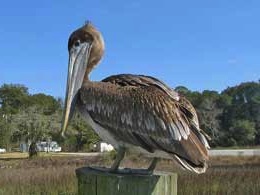 Recently, someone brought to my attention a wave of “mysterious pelican injuries and deaths” in North Carolina. Dozens of brown pelicans have washed up on the shore with broken wings and other injuries, according to the American Bird Conservancy. A local news report from WECT Wilmington has video and interviews with understandably concerned local residents.
Recently, someone brought to my attention a wave of “mysterious pelican injuries and deaths” in North Carolina. Dozens of brown pelicans have washed up on the shore with broken wings and other injuries, according to the American Bird Conservancy. A local news report from WECT Wilmington has video and interviews with understandably concerned local residents.
The pelicans haven’t gotten too much press—yet—but the story reminded me of January’s “Aflockalypse,” a kind of media hiccup where several reports of mass animal deaths, kicked off by a nice mass keel-over of blackbirds in Arkansas, all rose to the public consciousness at the same time and began to seem to some like a grim portent of…something. The Washington Post’s Melissa Bell summed it up at the time. It was, she guessed, “a self-fulfilling prophecy: "when one news report about dead birds becomes big news, a few dead birds anywhere in the world becomes big news.”
Larry Madoff runs ProMED mail, the email news source on global health events—human and animal. And he says that mass die-offs are very common. “We see something or hear something like this maybe one a week, and that is probably an underestimate of how often it is happening.”
The reasons behind the deaths are a “mixed bag,” he says–weather, disease, toxins and some that remain mysteries. Just searching “die-off” in his archives reveals more than a dozen such events so far this year, from an undiagnosed die-off of poultry in Azerbaijan to hundreds of dead harp seals washing ashore in Newfoundland and Labrador tentatively blamed on the lack of sea ice.
So why didn’t those mass deaths make it big with the media or online? Why no frenzy over the Caucasus Chicken Catastrophe or the Newfoundland Sealocaust? Maybe because the sites are comparatively remote. “When die offs happen where people are, it makes an impression,” says Madoff. “One reason it may appear that we are seeing more of it is just population expansion into previously pristine areas.”
So why are mass deaths so common? I’d like to her from population ecologists on this point, but here’s one reporter’s guess. Since animals of the same species are very genetically similar, we should expect that if a new environmental factor kills one, it will kill many. And since the environment is always changing (especially with us humans running around), we should expect many mass animal deaths. On the other hand, they could be signs of the impending apocalypse.
Photo credit: Dick Daniels
Recent comments on this blog
Experiments reveal that crabs and lobsters feel pain
US research ethics agency upholds decision on informed consent
Chemistry credit disputes under the spotlight
Chemistry credit disputes under the spotlight
Contamination created controversial ‘acid-induced’ stem cells